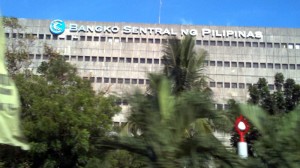BSP tightens policy settings; key rates unchanged

The Bangko Sentral ng Pilipinas kept the benchmark overnight borrowing and lending rates at their record lows of 3.5 and 5.5 percent, respectively, on Thursday. INQUIRER.net file photo
MANILA, Philippines—Monetary officials started tightening policy settings on Thursday, starting with a hike in deposit reserve requirements for banks amid record growth in the country’s money supply.
“The decision … is intended to guard against potential risks to financial stability that could arise from continued strong liquidity growth and rapid credit expansion,” Bangko Sentral ng Pilipinas (BSP) Governor Amando M. Tetangco Jr. said in a statement.
The reserve requirement for banks was raised by 1 percentage point to 19 percent for universal and commercial banks, a move that is expected to mop up P60 billion in cash from the economy.
This was the first adjustment in reserve requirements since April 2012.
Benchmark overnight borrowing and lending rates were kept at their record lows of 3.5 and 5.5 percent, respectively. Rates for special deposit accounts were also held at their current 2 percent across all tenors.
Article continues after this advertisement“This is something that will be felt immediately with the banks,” BSP Deputy Governor Diwa C. Guinigundo said at a press conference after the announcement.
Article continues after this advertisement“It’s possible that lending rates may go up because reserve requirements are a cost to the banks,” Guinigundo said.
Higher rates would ease demand for loans from consumers and households, helping rein in excessive demand pressures that would otherwise push up consumer prices.
The official said the adjustment would lead to a slowdown in lending and domestic liquidity growth for the rest of the year.
For February, domestic liquidity or the amount of money in the economy rose by a record 38.6 percent, while bank lending expanded by 17.1 percent.
It has been three years since the BSP tightened policy settings. The last time was also an adjustment in reserve requirements to 21 percent for universal and commercial banks.
Changes in policy settings at Thursday’s meeting were widely expected, following Tetangco’s statements earlier this week, saying he favored an “early” adjustment amid inflation pressures.
The Monetary Board also revised its forecast for average inflation for the year to 4.2 percent from the previous projection of 4.3 percent.
This is within the BSP’s official 3 to 5 percent target range for the year.
Next year, the BSP’s inflation target was set at a lower 2 to 4 percent. The new forecast for 2015 inflation was revised to 3.2 from 3.3 percent.
At its latest policy meeting, the US Federal Open Market Committee (FOMC) decided to reduce the Federal Reserve’s bond-buying program by another $10 billion.
Starting April, the US Fed will buy mortgage-backed securities and US Treasuries at a rate of $55 billion, lower than the original pace of $85 billion a month.
The bond-buying program, known as quantitative easing (QE), was introduced in late 2009 to help drive down interest rates and aid the American economy’s recovery from the global financial crisis.
Improving conditions in the United States, where unemployment has slowly gone down and home prices have gone up, prompted the US Fed’s decision to start scaling back QE to allow the American economy to stand on its own feet.
In a separate statement on Thursday, Tetangco said the average rise in consumer prices for March would settle at between 3.7 and 4.6 percent. This compares to February’s 4.1 percent.
“Upward price pressures could come mainly from rice prices due in part to the ongoing lean season,” the central bank chief said.
“However, lower electricity rates and petroleum prices could offset some of the upside pressures,” Tetangco added.